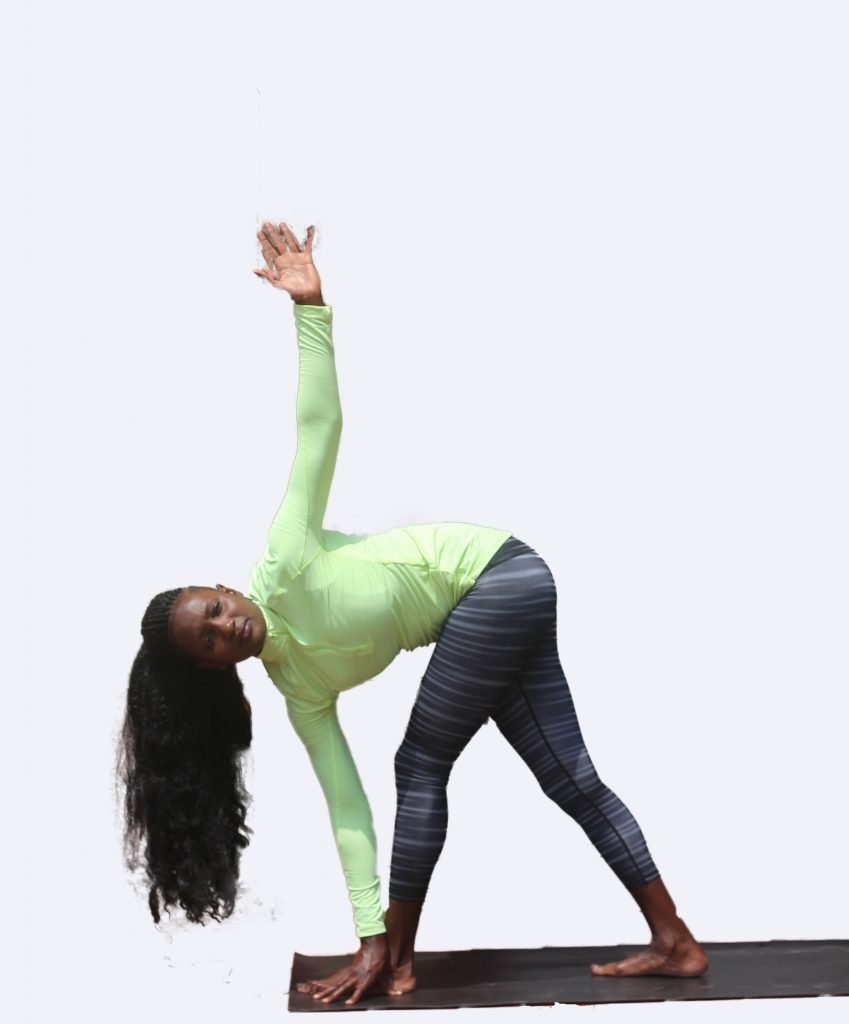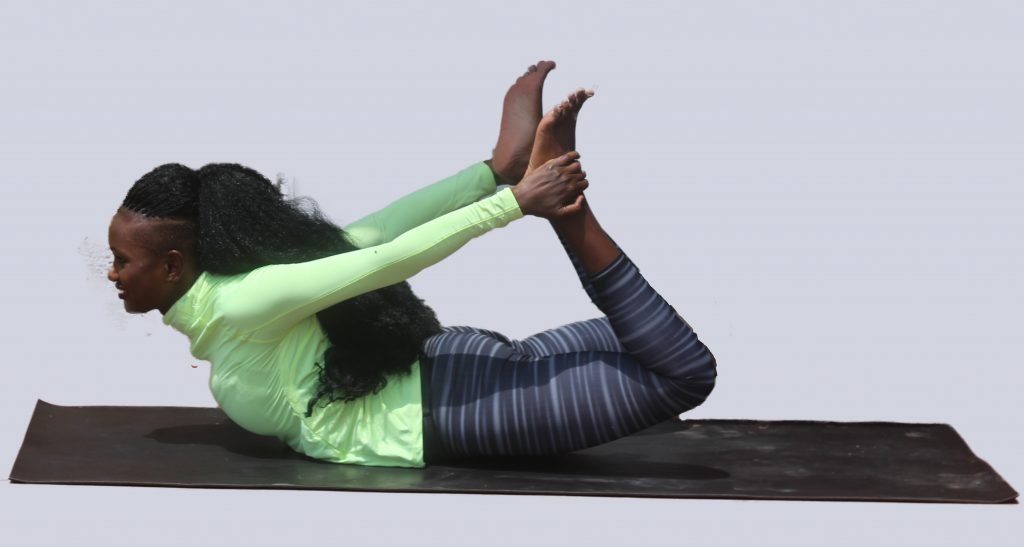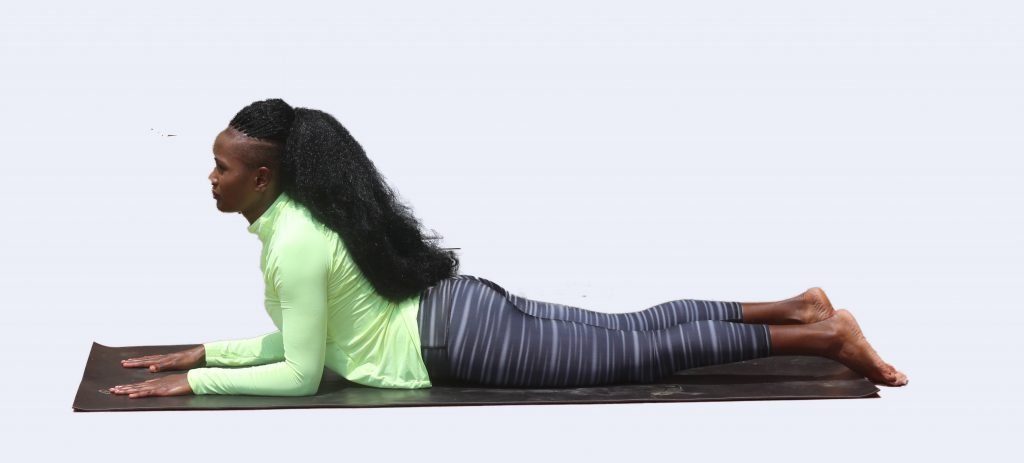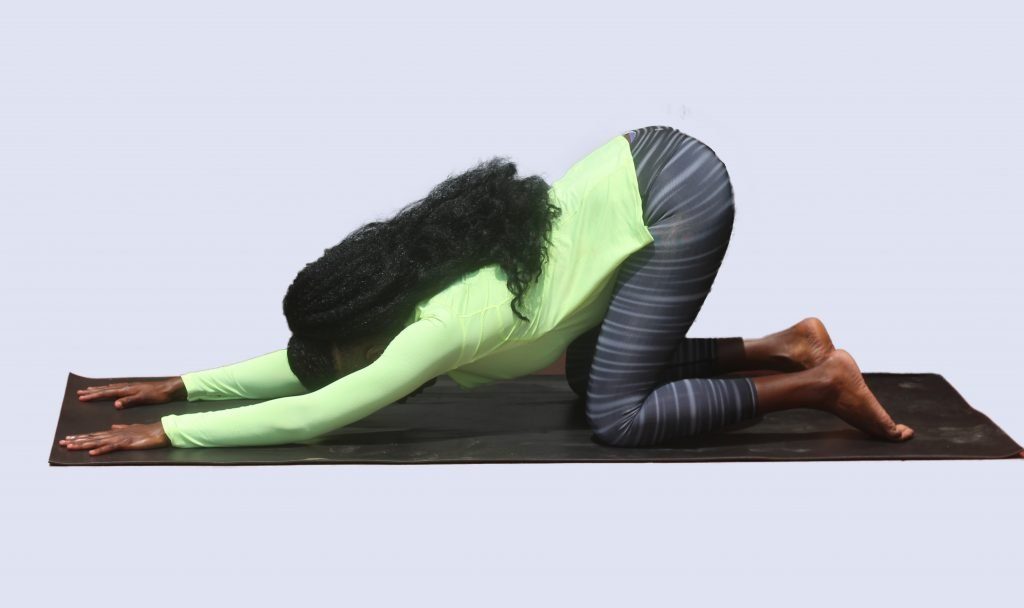by Winnie Murugi: Is your digestive system feeling clogged? Does the long call of nature feel somewhat unnatural?
You may be constipated. Some common symptoms of constipation include difficulty passing stool, lumpy stool, feeling bloated, and stomach ache among others.
Constipation comes down to reduced bowel movement- it causes food to spend more time in the colon. As a result, most water in the food being digested is reabsorbed to the body causing the fecal matter to be dry and hard, hence difficulty passing stool.
There are a number of factors and triggers associated with constipation, among them stress, a weak digestive system muscles, and physical inactivity. The three can be alleviated through yoga.
How Yoga Helps to Relieve Constipation
- Massaging the digestive system
On forward bending postures, the pressure of the thighs against the belly offers massage to the digestive organs hence promoting bowel movement.
- Increases blood circulation to the digestive organs
Yoga promotes blood circulation throughout the body. It particularly increases blood circulation to the digestive organs when doing yoga poses that aid in constipation. Increased blood flow to these organs means that there is an adequate supply of oxygen thus promoting their optimal functioning.
- Tones the digestive organs muscles
Doing yoga poses that involve twisting and bending, puts gentle pressure on the internal organs. As a result, the tissue muscles activate to handle the incoming pressure ultimately resulting in stronger, well-toned digestive organs’ tissue muscles.
- Helps to relieve stress
Why does stress cause constipation? The brain is constantly communicating with all other body organs for them to optimally function, including the digestive tract. The gastrointestinal tract is made up of numerous nerves which trigger normal spasming in the gut hence leading to normal bowel movement. However, when you are stressed, the brain triggers irregular spasming. Frequent spamming leads to diarrhea while fewer spasms lead to constipation.
A 2018 research on the effects of yoga on stress concluded that yoga significantly reduces stress, anxiety, and depression. Doing yoga lowers stress hormones levels-cortisol and adrenaline, and boosts the release of endorphins. When the brain is not stressed, it functions effectively and promotes peak functioning of other body organs including your digestive tract.
- Increases metabolism
When the digestive tract is operating optimally, food does not stay in the system for a longer or shorter time than usual, digestive enzymes levels are at optimal, and every organ is doing its part well. This leads to a healthy metabolism. Constipation is evidence of an ill-functioning metabolism. Yoga poses for constipation promote normal hormonal functions, the release of toxins, improved blood circulation, and strong organs which allow the body to resume normal metabolism.
- Helps in the elimination of toxins along the digestive system
Twisting poses cause a gentle squeeze and compression on the digestive system which triggers and promotes wringing out of toxins from the colon, pancreas, and liver.
14 Yoga Poses for Constipation
Any yoga pose improves circulation throughout the body and helps to relieve stress, both aspects are helpful in alleviating constipation. However, any yoga pose that involves twisting the torso from the lower back or core, forward bending, inversions, or lying on the belly directly activates the abdominal muscles and digestive organs connective tissues; therefore, helping to ease constipation.
Keep in mind that deep breathing is an integral part when doing yoga as it helps in relieving stress and promotes adequate circulation of oxygen in the body. The recommend pranayama technique when doing the poses above is Ujjayi breathing.
Below are 14 yoga poses that aid in relieving constipation.
1. Wind Removing Pose
Sanskrit: Pavanamuktasana
The wind-removing pose is so called because it may trigger you to pass gas especially if you are bloated. It activates the entire colon muscles (transverse, ascending and descending) hence promoting peristalsis, and easing constipation.
Wind Removing Pose
How to do it:
- Lie on your back with feet straight and hands beside your body.
- Pull both knees towards the chest and hug them in with your interlaced fingers or elbows.
- Keep your shoulders, neck and head on the floor.
- Hold for 10-20 breaths.
Modifications
- If you have a big belly or tight hip flexors that make it difficult to pull both knees to your chest, pull one knee only and leave the other leg extended.
- If you are flexible and are looking for a more advanced variation, hug both knees in tightly, lift your shoulders and neck off the mat and bring your head towards the knees.
2. Seated Supine Twist
Sanskrit: Ardha Matsyendrasana
As you twist, the kidneys, intestines, pancreas, and liver get a gentle squeeze and massage which promotes toxin elimination and bowel movement. This pose also increases blood flow to the digestive organs.
How to do it
- Sit upright with your legs extended in front of you.
- Bend your right knee to point up.
- Hug the left knee with your right elbow
- Twist gently and place your left hand behind you, next to your seating bones
- With every inhale lengthen your torso more, and with every exhale twist more.
- Hold for 10 breaths
- Switch sides
Modifications
- A more advanced option would be to take your elbow outside the bent knee.
- An easier option is to pull in the knee with your hand instead of the elbow.
3. Supine twist
Sanskrit: Supta Jathara Parivartanasana
Twisting activates the abdominal organs which promotes toxin elimination and blood circulation. Since you are lying down, this posture puts less stress on the spine.
How to do it
- Lie on your back with the legs extended.
- Bring your right knee to your chest.
- Take the right knee across your belly to rest on the mat on the left side.
- Using your left hand press the top of the left knee to keep it down.
- Adjust your torso to keep it straight – both shoulders squared on the floor.
- Extend your right hand.
- Turn your head to face towards the extended hand (your right side).
- Hold for 10 breaths.
- Switch sides.
Modifications
- You can bend the extended leg to ease tension on the lower back.
- Look up instead of turning the head to face the opposite direction.
- Bend both knees and twist them towards one side.
4. Plow Pose
Sanskrit: Halasana
The plow pose is an inversion that increases blood circulation to the brain and calms the sympathetic nervous system hence promoting relaxation. It activates and tones the abdominal muscles and organs. The gentle compression on the waist area massages the abdominal organs promoting digestion.
How to do it.
- Lie on your back with legs extended.
- Bend your knees and bring them towards your chest.
- Propel your hips up and take your feet past your head so that your weight is supported by your shoulders (not on the neck), and the tips of your toes are on the ground.
- Hold for 10 breaths.
- To come out of the postures, gentle roll down until your entire back is on the mat.
Modifications
- Instead of taking your feet all the way past your head, lie back and lift your legs so that they are at a right angle to your torso. Hold the backs of your thighs with your hands and pull the quads as close to the chest as possible. Hold for 5-10 breaths.
***This is an advanced level posture and may not be ideal for beginners. Do not do it if you have back, neck or shoulder injuries.
5. Crescent Twist
Sanskrit: Anjaneyasana
The crescent twist is a variation of the crescent lunge. It is a full-body vitality pose that increases blood flow throughout the body. The twisting aspect of the asana is especially beneficial for constipation as it applies gentle pressure on abdominal organs toning them and promoting wringing out of toxins.
How to do it
- Begin in the crescent lunge on the right side.
- Bring your hands to prayer position at the heart center.
- Slightly lean forward and place your left elbow on the outside of your bent right knee.
- Lengthen your torso, press your palms together, and twist.
- Gaze up past your right shoulder.
- Hold for 10 breaths. With each exhale twist more.
- Release and switch sides
Modification
- Drop your back knee to the ground.
6. Revolved Triangle Pose
Sanskrit: Parivrtta Trikonasana
This posture invigorates the entire body thus promoting blood circulation throughout. The twist aids in digestion and promotes bowel movement.
Revolved Triangle Pose
How to do it
- Begin in triangle pose on the right side.
- Shorten your stance and turn your back leg slightly in to a 60-70 degrees’ angle.
- Drop your left hand a few inches beside your right foot.
- Lengthen your torso and twist such that you are facing towards the right side.
- Reach your right hand up.
- Hold for 5-10 breaths.
Modification
- Place your hand on a yoga block instead of reaching your palm to the floor.
7. Twisted Chair Pose
Sanskrit: Parivrtta Utkatasana
The twisted chair pose works your lower body and upper body muscles while stimulating and massaging the abdominal organs.
How to do it
- Come to standing with feet together and hands beside your body.
- Bring your hands together to a prayer position on your heart center.
- Bend your knees and sit back, as you would when taking a seat.
- Take your right elbow on the outside of your left knee.
- Press your palms together and twist.
- Hold the pose for 10 breaths.
- Release and switch sides.
- When doing this posture, ensure that your pelvis remains neutral. Keep your knees together and inline.
Modifications
- Instead of placing your elbow on the outside of the opposite knee, separate your feet hip-width apart and place a block between the big toes. To twist, press the opposite hand on the block. This variation gives you better stability in the pose.
8. Locust Pose
Sanskrit: Salabhasana
The locust pose not only massages your internal organs but also strengthens and stretches the back, legs, and torso. It prepares the body for deeper backbends. The gentle massage on abdominal organs helps to ease constipation and constipation-related symptoms such as flatulence.

Locust Pose
How to do it
- Lie on your belly with your hands beside your hips.
- Separate your legs hip-width apart.
- Clasp your hands behind your back.
- Take a deep inhale and press your quads on the ground.
- Lift your toes, shins, chest and head off the mat, and the clasped hands off your back.
- Keep pressing your quads on the ground and with every inhale, lift higher.
- Hold the posture for 5-10 breaths.
Modifications
- Instead of clasping your hands at the back, you may opt to leave them besides the hips, then lengthen and lift them slightly when you come up in the posture.
9. Bow Pose
Sanskrit: Dhanurasana
This posture is referred to as the bow pose because it puts the body into a shape of an archers’ bow. Your belly presses down on the ground; as a result, it takes more effort to breathe. The strained deep breathing causes you to contract the abdominal muscles which propels the contents of the food and fecal matter down the gastrointestinal tract. The ground also massages your abdominal organs hence promoting bowel movement.
Bow Pose
How to do it
- Lie on the down on your belly – face-down, palms beside your hips, legs extended and top of your toes on the mat.
- Bend your knees such that your feet are pointing up.
- Reach your hands backward to grab your ankles.
- Lift your chest and thighs off the mat – your shoulder blades are pressing towards each other and chest is facing forward.
- Hold for 5-10 breaths.
Modifications
- If you are not yet flexible or strong enough to hold both legs up at the same time, rest one hand in front of you and reach the other backward to hold the leg on the same side. For instance, place your right hand under your chin, and reach the left hand to the back to hold the left leg. You may lift the head up or keep it on the ground. Ensure to switch sides.
- You could also place a folded blanket under your belly and a yoga block beneath the hand that is in front.
10. Sphinx Pose
Sanskrit: Salamba bhujangasana
The sphinx pose is a beginner-friendly pose that offers you thebenefits of a backbend while massaging your belly. As you lie on your stomach, the floor puts gentle pressure on the abdominal organs hence promoting peristalsis.
How to do it
- Lie on the down on your belly – face-down, palms beside your hips, legs extended and top of your toes on the mat.
- Bring your hands forward and rest on your elbows directly under your shoulders, fingers spread, palms pressing down.
- Press down and lift your head and chest off the floor. Squeeze your shoulder blades towards each other. Keep the torso lengthened to avoid compressing the spine at the lower back.
- Hold for 10 breaths.
Modifications
- Instead of resting your elbows under your shoulders, extend your arms all the way forward and lift your upper chest, neck, and head.
- Or, place a folded blanket under your belly and keep your elbows bent beneath your shoulders.
- You could opt to place the folded blanket beneath your elbows instead of under the stomach.
11. Cobra Pose
Sanskrit: Bhujangasana
The cobra pose elongates the whole body with a focus on the front side. As you press your hands down and lift the chest, the belly area lengthens stimulating the abdominal organs. The gentle pressure of the ground on the belly offers a gentle massage that nudges bowel movement.

Cobra Pose
How to do it
- Lie on the down on your belly – face-down, palms beside your hips, legs extended behind you and top of your toes pressing against the ground.
- Place your palms beside your chest.
- Press your elbows into the body, press your palms and thighs down and lift the chest up to take a slight backbend. (Lower ribs and belly remain on the ground and elbows remain slightly bent).
- Hold for 5-10 breaths.
Modifications
- Place a rolled blanket beneath your ribs for extra support.
12. Upward Facing Dog
Sanskrit: Urdhva Mukha Svasana
The upward facing dog pose builds upper body strength while stretching the chest and abdomen. The lengthening of the abdomen awakens abdominal muscles and improves circulation to abdominal organs. It takes more effort to breathe to the abdomen on the pose which causes the digestive organs to contract, aiding in peristalsis.
How to do it:
- Lie on your belly, face down and palms beside your hips.
- Bring your hands to press on the ground against your ribs.
- Press your palms and the tops of your feet on the ground as you lift your chest, abdomen, pelvis, quads, and knees off the mat.
- Straighten your elbows, taking care not to lock them.
- Squeeze your shoulder blades towards each other, and drop the shoulders away from your ears.
- Lengthen your torso and take a backbend.
- Gaze forward or tilt your head to gaze up.
- Hold for 10 breaths.
Modifications
- This pose can be challenging for beginners, and the wrong alignment can lead to writs and back injury. Avoid collapsing the weight of your arms on the wrists by keeping your shoulders and triceps active.
- Keep your torso lengthened to prevent the lower back from compressing.
- You may drop your knees and quads to the ground and lift from your pelvis. Or, placed a rolled blanket beneath your quads.
- If doing the upward facing dog is too difficult, skip it entirely and instead take the sphinx pose or cobra pose.
13. Puppy Dog Pose
Sanskrit: Uttana Shishosana
The puppy dog pose is also known as half dog pose or heart-melting pose. It is a beginner-friendly variation of child’s pose that offers the benefits of an inversion and a forward bend. It aids in relieving constipation by lengthening abdominal muscles as well as activating the abdominal organs in the mini-forward bend.
How to do it
- Come to your fours, resting on your Hands and knees
- Walk your hands in front until your forehead is on the ground or a few inches from the ground
- Keep the hips stack directly above the knees
- Slightly arch your back.
- Rest in the posture for 10 breaths
Modifications
- Place a thin blanket under your knees to ease the pressure of the ground on the kneecaps.
- Place a folded blanket under your chest especially if you are having difficulties getting your chest and your head to the ground.
- Place a folded blanket between your belly and the thighs. The blanket offers extra massage on the belly aiding bowel movement.
14. Seated Forward Bend
Sanskrit: Paschimottanasana
As you hinge from your hip joint and rest your belly and chest on the thighs, the pressure of the quads against the belly offers a gentle massage to the intestinal organs. This posture has an immediate calming effect on the nervous system hence relieving stress. Besides the obvious benefits of seated forward bend in relieving constipation, the asana offers a deep stretch to the backside of the body including the spine, neck, glutes, hamstrings, and calves.

Seated Forward Bend
Contraindications for Doing Yoga Poses for Constipation
Avoid performing the above yoga poses if you suffer from hyperthyroidism, sciatica, diarrhea, you have back or neck injury, you recently underwent abdominal surgery, or you are recovering from a hiatal hernia.
Conclusion
You can select a few of the above poses or practice all of them. If need be, modify and use props to help you with getting and holding the postures. If you find any of the postures too difficult to do, do not push your body as you risk injuries. Rather, identify those that are easier to do and work with those.
Besides practicing yoga for constipation, ensure to eat healthily (nutrient dense fibrous foods), and hydrate adequately to alleviate constipation and other digestive system problems. If constipation persists, consult with your doctor.
Incorporating yoga into your lifestyle offers numerous benefits and can help to improve your overall health. If you are beginning out, either find a good yoga instructor or sign up for yoga classes at a yoga studio near you.






















































